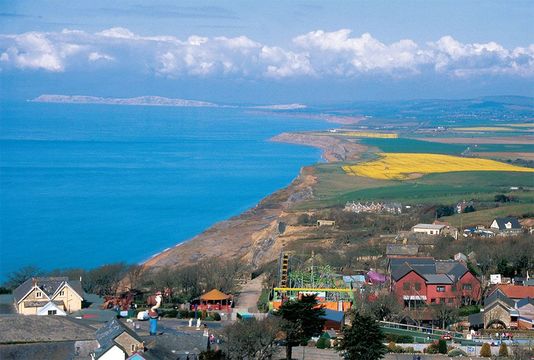
On the island of garlic and grockles.
For a sheer scenic wonder, travel over the sea to Skye; for Celtic mystery, cross the causeway to Lindisfarne; but for sunshine and fun, hie thee to the Isle of Wight. For generations now, people have flocked to the pretty island, drawn not only by its traditional seaside resort towns and their accompanying distractions but also by the monuments of its eclectic history and the easygoing charms of its way of life. Not surprisingly, a broad array of tourist attractions has grown to entertain the visitors and separate them from their shillings.
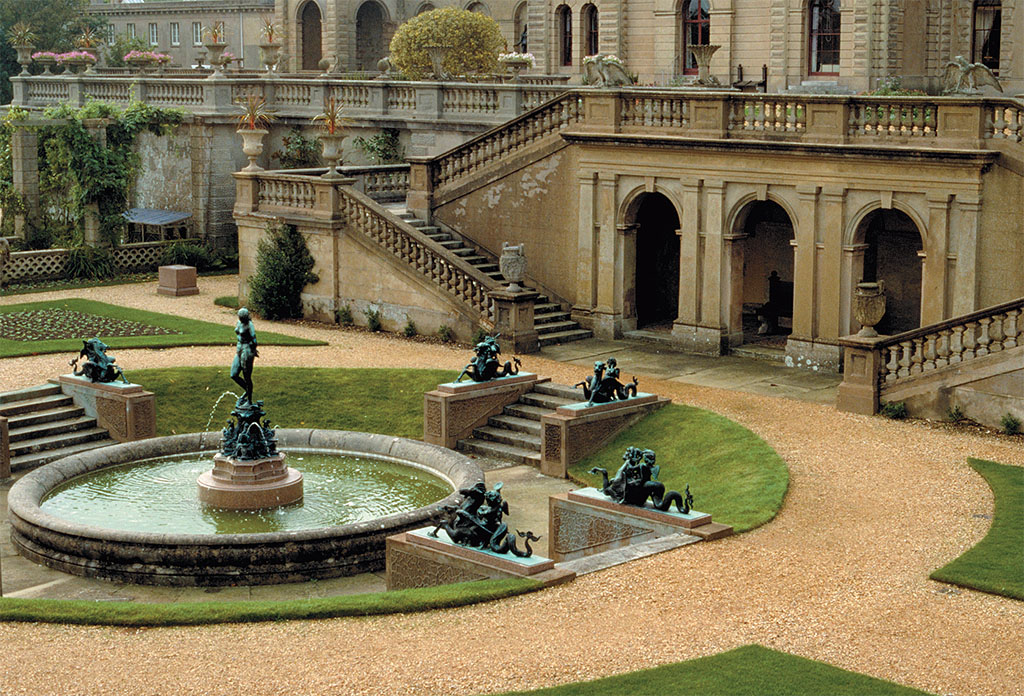
DANA HUNTLEY
The Solent, a broad channel 25 miles long and up to five miles wide, separates Wight from the southern mainland coast of Hampshire. Wightlink Ferry makes the 45-minute crossing from Portsmouth to Fishbourne around the clock. Other ferries ply the Solent from Southhampton and Lymington. With up to 230 crossings a day, getting to the Isle of Wight (IOW) is never a problem. I made the easy crossing from Portsmouth, as, I learned, people have been doing for maybe 40,000 years.
At the Tourist Information Centre in Newport, a small admission is charged to the modest Museum of Island History. It displays artifacts of nomadic hunting parties dating back perhaps 35,000-50,000 years (there’s accuracy for you). The earliest actual settlers on the island seem to have been Bronze Age folk some 3,500 years ago. The Romans were here, too. Their presence can be seen at Brading Roman Villa, where the colorful mosaics are reckoned equal to any in Europe.
The first real flourishing of the island, though, occurred during Elizabethan times, when preparations for the anticipated invasion of the Spanish armada were entrusted to the island’s royal governor, George Carey. Inhabitants attribute that early golden age to Carey’s antipathy to lawyers, who were discouraged from settling here.
For centuries, IOW was politically a chunk of Hampshire, though the island now enjoys county status of its own. Newport is the island capital and the only inland town of any size. The island itself is 23 miles long and 13 miles wide, covering 147 square miles. As in every such geographically isolated outpost, islanders have their own terminology for life. Native-born islanders are called corkheads; residents who have relocated to IOW are overners; tourists and visitors are grockles.
Read more
It was really Victorian grockles who first started coming to the island for sun and fun. The Isle of Wight, after all, does have measurably the most sunshine in Great Britain. That’s reason enough in Britain for a place to draw the crowds. They have been coming to IOW ever since, and the island has grown its principal industry to house them, feed them and entertain them. White sand and shingle beaches along the eastern shore from Ryde to Ventnor have long provided a centerpiece for those famous English seaside holidays.
The island’s biggest single draw for visitors today, though, is Osborne House in East Cowes, Queen Victoria’s splendid palace by the sea. This was the family home, rebuilt by her beloved Prince Albert, where she and Albert raised their large brood of children and to which she withdrew to spend much of her time after his death in 1861. Queen Victoria herself died here in 1901.
Perhaps nowhere in Britain can ordinary folk like you and me get a more intimate view of a royal family’s domestic life and history than at Osborne House. From Swiss Cottage, the miniature chalet built as a playhouse for the royal children, to the walled fruit and flower garden and the hothouses of exotic plants, the sumptuous royal apartments and private family rooms, the entire regal estate is a working commemoration of the monarch who gave her name to the era of the British Empire’s greatest triumph. Osborne House is a must-see visit, at once awe-inspiring and surprisingly intimate.
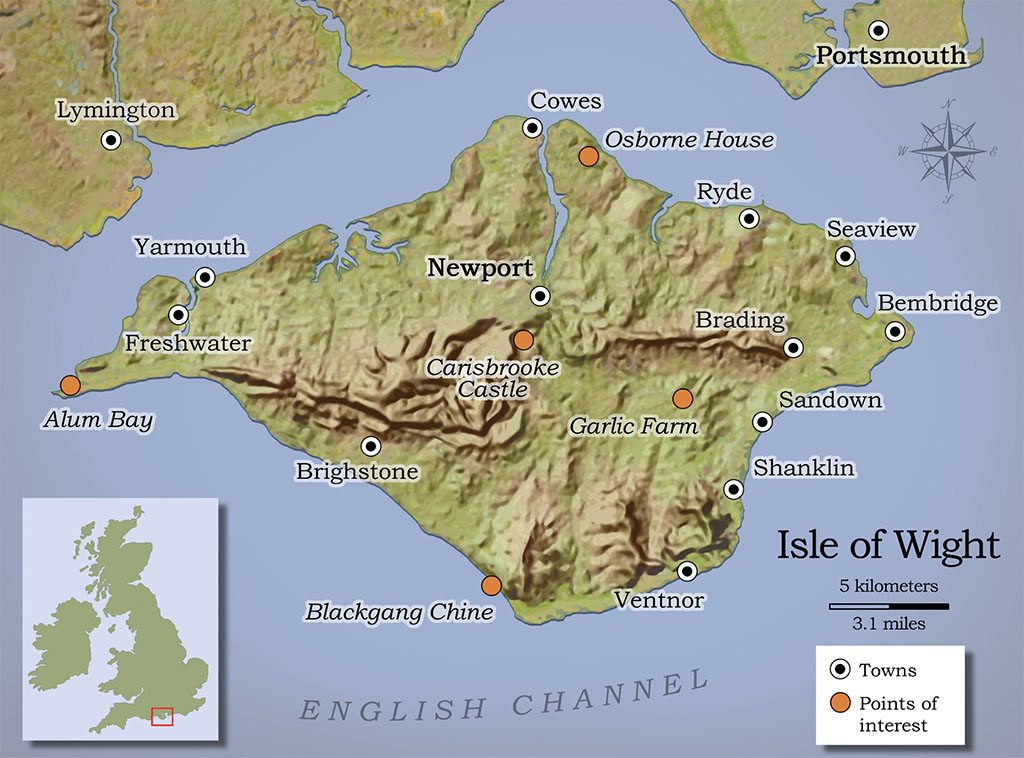
GREGORY PROCH
Even before Queen Victoria’s arrival, Cowes was becoming the center of British yachting. It still is. The first America’s Cup race took place at Cowes in 1851. Throughout the clement months, regattas and boat racing take place in one form or another virtually every weekend. The biggest single annual Solent race is the Round the Island Race held in June, which can attract 2,000 yachts. There is also the 600-mile Fastnet Classic that starts in the Solent off Cowes. The famous Cowes Week Regatta, held annually the first week of August, dates from 1826.
At the end of The Parade is Cowes Castle, home of the Royal Yacht Squadron, Britain’s most prestigious yacht club. Prince Philip is the admiral. “The starting cannon may be fired at any time,” warns a sign out front. Lining the parade are holiday condos, many dating from the Art Deco era, their broad balconies facing north over the Solent—the better to view the racing.
Carisbrooke Castle near Newport is the island’s most important fortress. There has been some sort of defensive structure on its grounds since Roman times. Anglo-Saxons fortified it in the 8th century and walled it against the Vikings 200 years later. After the Norman Conquest, William the Conqueror gave the castle, and the island, to one of his friends. For succeeding centuries, ownership of Carisbrooke Castle went with lordship of the Isle of Wight. Most famously, Carisbrooke was the prison of King Charles I for the last 14 months of his life—before the unhappy monarch was returned to London for his trial and beheading in 1649. Personal relics of Charles I, documents and Civil War armor and weaponry form the principal exhibit of the castle’s museum, founded by the island governor and youngest daughter of Queen Victoria, Princess Beatrice, in 1898. As governor of the Isle of Wight, Princess Beatrice resided at Carisbrooke Castle until her death at 87 in 1944.
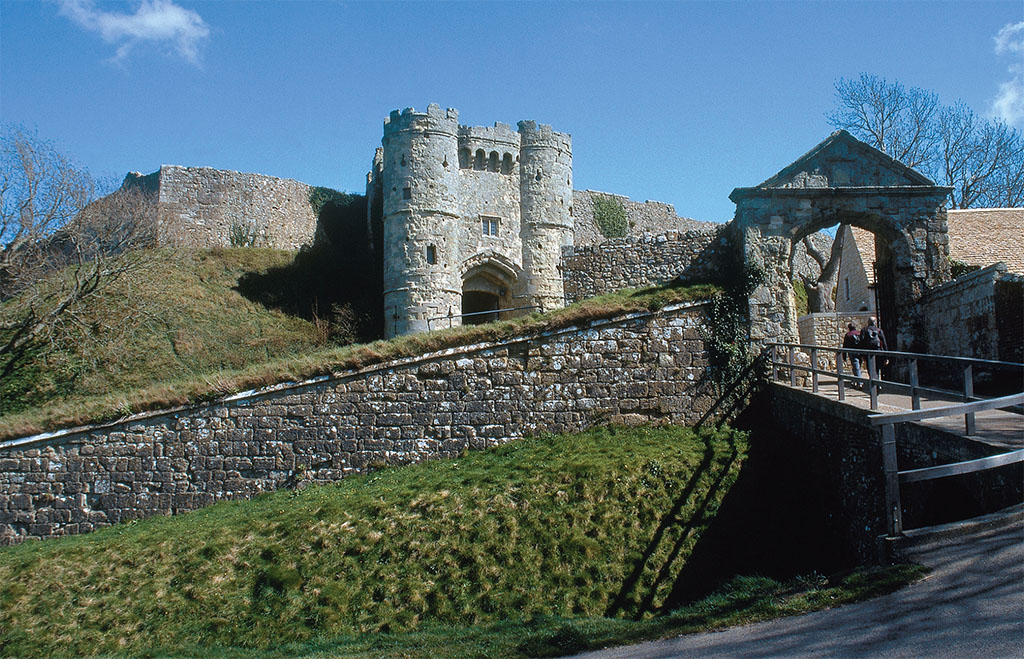
DANA HUNTLEY
Though Newport is the county town, the largest is Ryde, with a population of some 30,000. From Ryde, you can catch a Hovercraft over to Southsea in Portsmouth Harbor, a 10-minute trip that would take 45 by ferry. Ryde’s commercial downtown looks similar to that of any English town its size. Down on the Esplanade, though, it becomes obvious the town was built for seaside pleasures. In a freshwater lagoon, you can ride swan-shaped paddle boats, sharing the water with real swans. Across the Solent rises the skyline of Portsmouth and the Spinnaker Tower.
Near the eastern tip of Wight, the Bembridge Windmill is the only surviving windmill on Wight. Built in the early 1700s with local limestone, the tower stands 38 feet with a wooden cap resting on oak beams. The cap, with its drive wheel and sweeps, turns on original wooden cogs to face into the wind. It remained in continuous use grinding flour and cattle feed until it ceased operation in 1913. It’s now maintained by the National Trust, and is well worth seeing.
While much of IOW seems focused on leisure activities and the entertainment of visitors, the ancient roots of island life come sharply into focus at the church of St. Mary the Virgin in Brading. The 12th-century stone church was proudly built on the site of the first baptisms recorded on Wight, in 687.
Next door to the church is the Old Rectory Mansion; dating from 1220, it is the oldest house on the island. Its oak timbers are two centuries older, though, as it was built out of an earlier Anglo-Saxon house; below are evidence of Roman occupation. Quite anachronistically, the Old Rectory is now part of Brading the Experience, a waxworks museum that has grown to feature a taxidermy animal world, a chamber of horrors and the island’s largest collection of vintage wheeled vehicles. This is something to do if it rains.
On the East Coast, Sandown is the original Victorian seaside resort, replete with the obligatory tatty amusement pier stretching into the water. Large holiday hotels and guesthouses of every description line the broad curve of beach and spill up the cliffsides of the busy commercial district.
Just to the south, Shanklin is a smaller version of seaside sameness, a little more quaint and picturesque, perched atop 100-foot sandy cliffs facing the morning sun. Shanklin Old Village grew up around Shanklin Chine, one of a number of precipitate gorges carved into the east and south coasts of the island. “Chine” is one of those local words, used to describe deep ravines created over the eons by water cutting into the soft limestone. Shanklin Chine provides a naturally protected, lush environment for rare plants, thick with trees and undergrowth and a cascading waterfall. It’s as close to a tropical rain forest as it gets in Britain
.Shanklin Chine was perhaps the island’s first tourist attraction, with Jane Austen and John Keats among the visitors who have sung its praises. In earlier centuries, it provided a haven for smugglers and wreckers operating along the south coast. I took dinner one evening at an 18th-century stone pub at the head of the chine. Henry Wadsworth Longfellow described it during his stay in 1868 as “the lovely little thatch-roof Crab Inn, all covered in ivy and extremely desirable.” He could use the same words today.
‘It’s a delightful cross section of quirky amusements, natural wonders and historic sites’
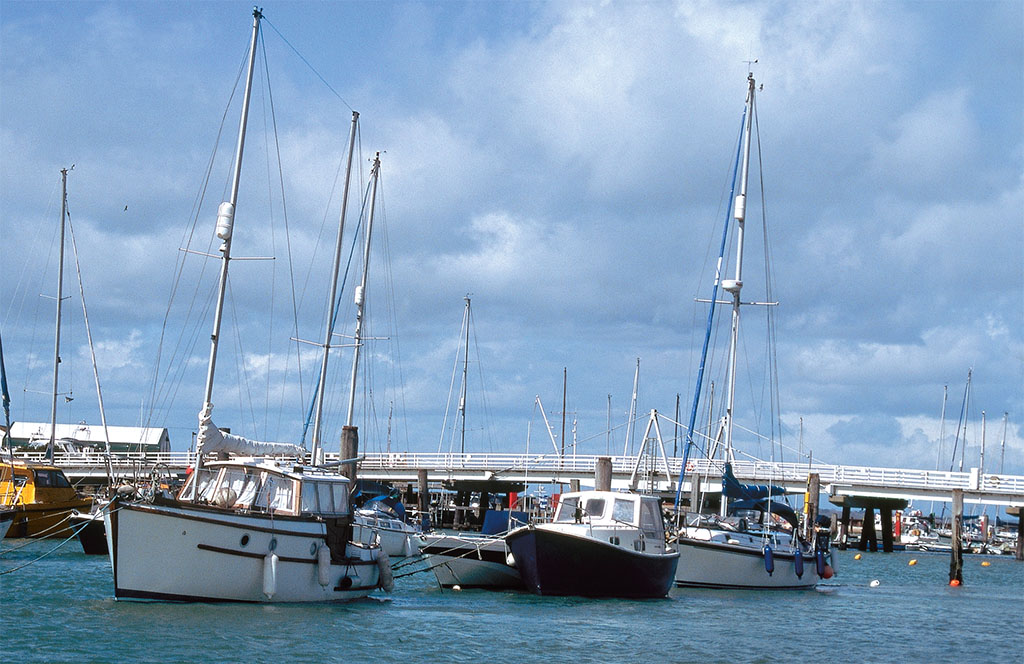
DANA HUNTLEY
South of Shanklin, the bustling coast quiets. On the southeast corner, Ventnor provides a more sedate alternative for those seeking seaside fun. The beachfront is broader, and decorated with flowers. A blue plaque on one house notes that Ivan Turgenev spent some time here in 1860, working on his masterpiece Fathers and Sons. To the west of town, Ventnor’s Botanic Gardens offer free admission to 22 acres of woodland and gardens full of flowers and plants that will grow nowhere else in Britain—a palm garden and a colorful Mediterranean terrace. The gardens are wonderful for a short stroll, or longer if you are really into the flora.
A little farther west, Blackgang Chine is one of the island’s best known attractions. An amusement park with traditional rides and entertainment, Blackgang Chine was opened in 1843—making it Britain’s oldest theme park. Unless you are traveling with children, though, you’ll drive past.
The southern coast of the island lacks the busyness and population of the northern and eastern coasts. There are open vistas of farmland, small chines disguising rivulets trickling down to deserted beaches and white chalk cliffs rising at the western end at Freshwater Bay. From there, Tennyson Downs stretches across the western end of Wight to Alum Bay. Named for the great Victorian poet Alfred, Lord Tennyson, the downs were home to the author for 39 years. His house, Farringford, is now a popular hotel. Many of the prominent writers of his age visited here, where Tennyson wrote many of his best-known works.
The Needles, stone outcroppings rising from the Solent like misplaced stalagmites, punctuate the western tip of IOW. Guglielmo Marconi built his first wireless telegraph station here in 1897, sending and receiving code to ships far out at sea. A plinth and monument mark the spot at Needles Park. The park itself features a chairlift down to the colored sands of Alum Bay several hundred feet below.
Inland Isle of Wight is much quieter. There are a few crossroads villages, but much of the rolling interior is given over to farming. Among IOW’s well-known commercial enterprises is The Garlic Farm. The popular farm shop features more varieties of the pungent root than you could have imagined exist. The farm’s own line of two dozen garlic pickles and relishes are shipped across the world: Transylvanian pickled garlic; pickled garlic with curry; vampire relish; fig, apple and garlic chutney; garlic and horseradish mustard; garlic mayonnaise and smoked garlic. I eagerly joined the crowd around the tasting table, all trying not to breathe on each other. In August, the annual Garlic Festival draws more than 20,000 people together to celebrate the savory bulb and its contribution to island life.
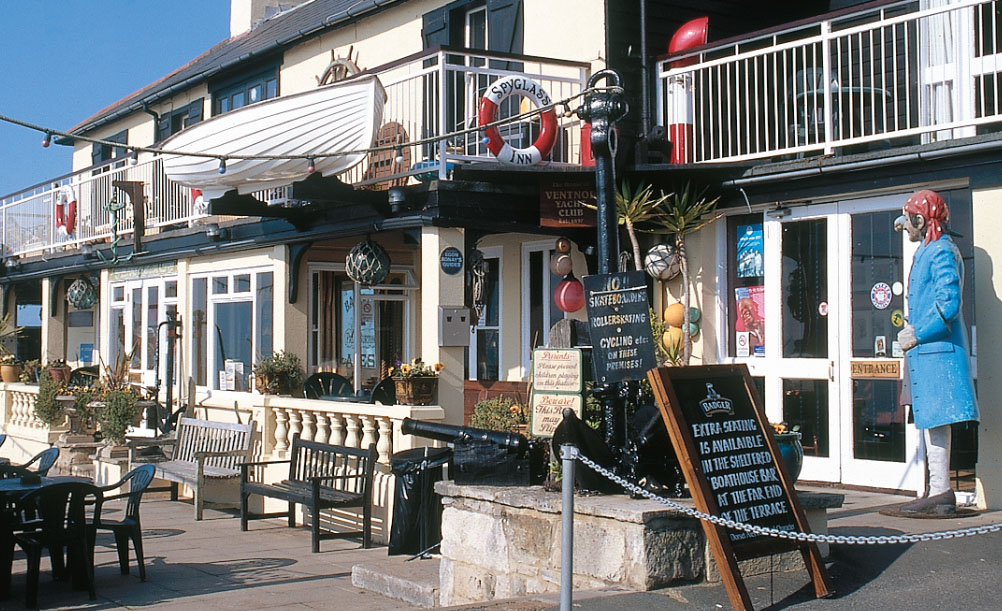
DANA HUNTLEY
One nice thing about an island, particularly one the size of Wight, is that it is clearly defined, compact and finite. Even so, I never did get to the zoo, the IOW steam railway, the ruined Appuldurcombe House or any of 40 other enticing options of history or entertainment designed for us grockles. From spring through autumn, the island features a dizzying calendar of events and festivals for locals and visitors alike.
* Originally published in 2008.





Comments